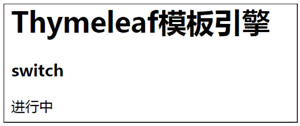Thymeleaf th:switch的用法(附带实例)
Thymeleaf 中使用 th:switch、th:case 标签进行多条件判断,与 Java 中的 switch 语句等效,根据条件显示匹配的内容,如果有多个匹配结果,只选择第一个显示。
th:case="*" 表示默认选项,即没有 case 的值为 true 时显示 th:case="*" 的内容,对应 Java 中 switch 的 default。
下面以数据状态为例来演示 th:switch 的用法:
1) 创建前端页面。在 templates 目录下创建 switch.html 页面,示例代码如下:
2) 添加后端程序:
3) 运行验证。启动项目,在浏览器中输入地址 http://localhost:8080/switch,页面显示效果如下图所示。

图 1 switch.html 页面显示效果
页面显示“进行中”的状态,可以在后台更改 status 的值来查看结果。由上图可知,switch.html 页面通过后台返回的 status 的值来显示不同的内容。
th:case="*" 表示默认选项,即没有 case 的值为 true 时显示 th:case="*" 的内容,对应 Java 中 switch 的 default。
下面以数据状态为例来演示 th:switch 的用法:
1) 创建前端页面。在 templates 目录下创建 switch.html 页面,示例代码如下:
<!DOCTYPE html>
<html lang="en" xmlns:th="http://www.thymeleaf.org">
<head>
<meta charset="UTF-8"></meta>
<title>Example switch </title>
</head>
<body>
<h1>Thymeleaf模板引擎</h1>
<h3>switch</h3>
<div >
<div th:switch="${status}">
<p th:case="'todo'">未开始</p>
<p th:case="'doing'">进行中</p>
<p th:case="'done'">完成</p>
<!-- *: case的默认选项 -->
<p th:case="*">状态错误</p>
</div>
</div>
</body>
</html>
在上面的示例代码中,使用 th:switch、th:case 标签根据后台返回的 status 的值显示匹配数据。2) 添加后端程序:
@RequestMapping("/switch")
public String switchcase(ModelMap map) {
map.addAttribute("status", "doing");
return "switch";
}
在上面的示例中,后台返回 switch.html 页面,同时返回 status 值为 doing。3) 运行验证。启动项目,在浏览器中输入地址 http://localhost:8080/switch,页面显示效果如下图所示。

图 1 switch.html 页面显示效果
页面显示“进行中”的状态,可以在后台更改 status 的值来查看结果。由上图可知,switch.html 页面通过后台返回的 status 的值来显示不同的内容。
 ICP备案:
ICP备案: 公安联网备案:
公安联网备案: